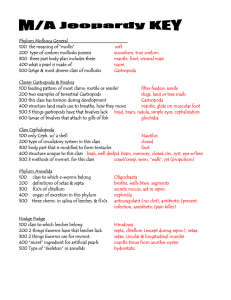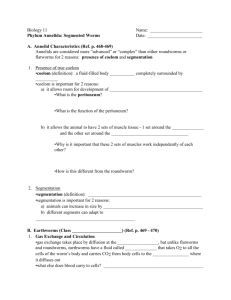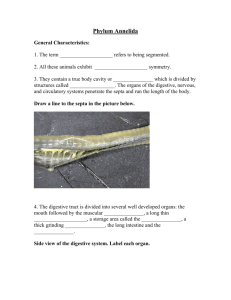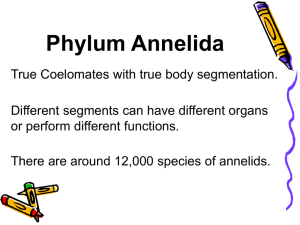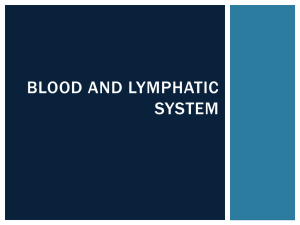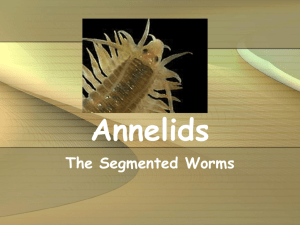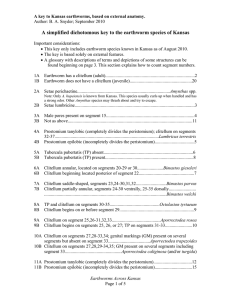Phylum Annelida
advertisement
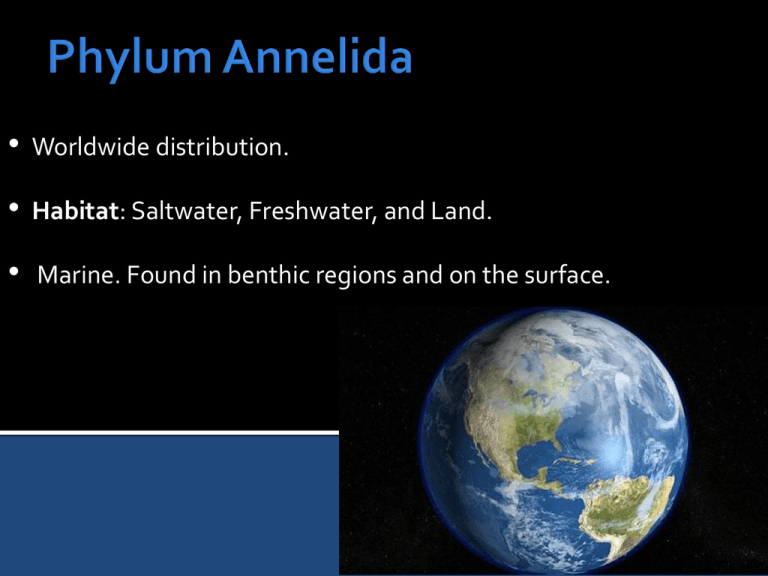
• Worldwide distribution. • Habitat: Saltwater, Freshwater, and Land. • Marine. Found in benthic regions and on the surface. Latin singular: Annulus Plural: Annuli Annelid • Metamerization- Division of the body into a series of repeating segments. • What other organisms, besides those in this phylum, are metameric? • What is the evolutionary advantage to metamerization? • Oligochaeta- Earthworms • Hirudinia- Leeches • Polychaeta- Freshwater/Marine worms • All Annelids (except leeches) have setae. • Setae- Short hairs/bristles. • Function: Anchor during movement. Short setae: land Long setae: aquatic • • • Body segments separated by septum Septum: Internal wall Closed circulatory system Well-developed nervous system (brain + nerve cords) Hydrostatic Skeleton: A skeleton made up of fluid under pressure in closed compartments. Longitudinal Muscle Circular Muscle Longitudinal Muscle Circular Muscle • Contraction of longitudinal muscles- shorten • Contraction of circular muscles- lengthen • Alternate muscular contractions: longitudinal, circular, longitudinal, circular, etc. Worm Ranch: http://dsc.discovery.com/tvshows/dirty-jobs/videos/worm-rancher.htm Eating a worm: http://dsc.discovery.com/tvshows/man-vs-wild/videos/whopper-worm.htm • Sexual & Asexual • Polychaets- Dioecious • Oligochaetes & Hirudinia- Monecious • Clitellum: leeches and earthworms Class Polychaets do not use clitellum for reproduction! • Oligochaetes & Hirudinia- Monecious •Clitellum: leeches and earthworms Class Polychaets do not use clitellum for reproduction! • Habitat: Primarily freshwater, few marine. Abundant in tropical regions. • Size: Most between 2-6 cm in length. • Color: Variety of colors and patterns: black, brown, red, or olive green. Monecious. After fertilization, clitellum secretes a mucous –like cocoon that receives eggs & sperm. Bury mucous cocoon in mud. Development process is similar to Oligochaetes. Medicinal uses: circulation, anti-clotting (Produces anticoagulant that prevents blood from clotting.) External parasite with suckers on each end. Habitat: mucous-lined burrows near low tide. Most active at night. Size: Grows up to 30-40 cm in length. Diet: Particle feeders. Use cilia or mucus to obtain food. Consume plankton. Parapoda: Appendages of Polychaetes. Function: Locomotion & breathing.
